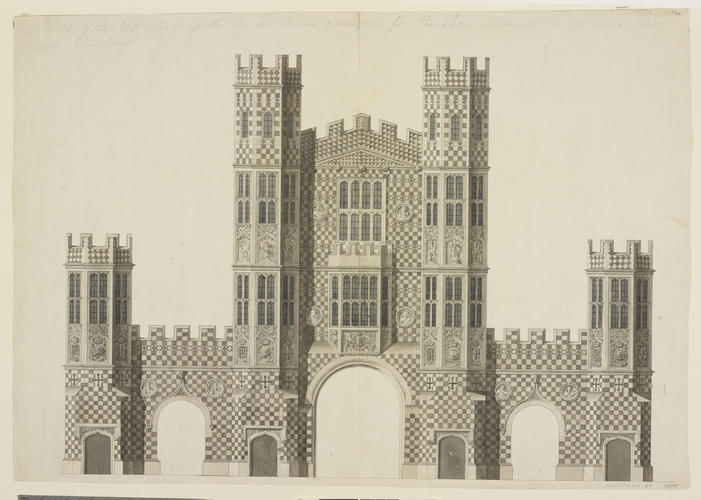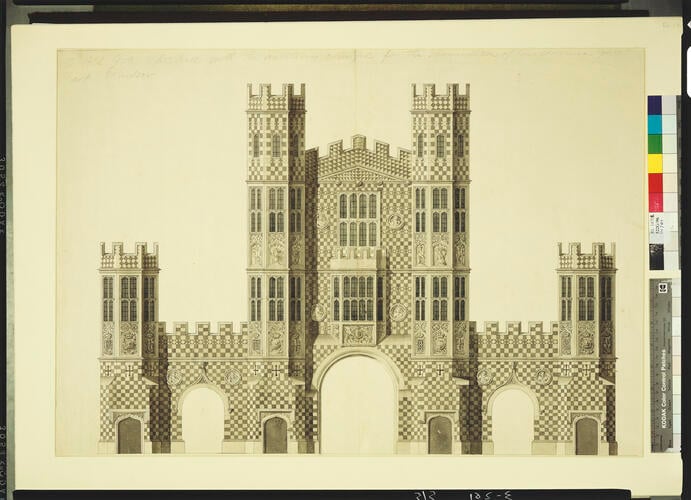-
1 of 253523 objects
The Old [Holbein] Gate, Whitehall, with the Additions intended for the Termination of the Avenue, Great Park, Windsor c. 1760
Pen and ink and wash | 48.4 x 69.4 cm (sheet of paper) | RCIN 914701
![The Old [Holbein] Gate, Whitehall, with the Additions intended for the Termination of the Avenue, Great Park, Windsor The Old [Holbein] Gate, Whitehall, with the Additions intended for the Termination of the Avenue, Great Park, Windsor](https://col.rct.uk/sites/default/files/styles/rctr-scale-1300-500/public/collection-online/4/6/445275-1391593452.jpg?itok=xs2xK0d4)
Thomas Sandby (1721-98)
The Old [Holbein] Gate, Whitehall, with the Additions intended for the Termination of the Avenue, Great Park, Windsor c. 1760


-
A pencil, pen and ink and wash drawing of the facade of the Holbein Gate, with Sandby's proposed additions for the removal of the Gate to Windsor Great Park. The original Gateway at the centre, with lower archways added on either side, battlements, and a turret over a porch at each end. Villedary watermark. Inscribed in pencil on the verso in the artist's hand: 'The Old Gate, Whitehall, with the Aditions [sic] intended for the Termination of the Avenue, Great Park, Windsor', and with the same inscription on the recto in a 19th century hand associated with the dealer Colnaghi.
The Holbein Gate was built in 1531-2, connecting two parts of Whitehall Palace otherwise separated by the road that passed between them. By tradition the gate was said to have been designed by Hans Holbein the Younger. Its rooms were used by Henry VIII for his wedding to Anne Boleyn. As draughtsman to William Augustus, Duke of Cumberland, Thomas Sandby was involved in plans to remove the Holbein Gate from its position outside the Banqueting House at Whitehall and redeploy it in Windsor Great Park. The Gate was demolished in 1759 in order to allow for the widening of the road, and the remains acquired by the Duke for the Park. The present drawing shows Sandby's proposals for extra wings to be added to the Gate in order to install it at the end of the Long Walk. The Duke's death in 1765 put an end to these plans, and parts of the Gate are now said to have been used to decorate houses in the Park. A drawing of Sandby's proposed additions was in his estate sale, 18 July 1799, no. 196, which could be the present sheet, and an aquatint dated 1 January 1804 was included in J. T. Smith's Antiquities of Westminster, London 1807, though the print is taken 'from an original drawing by T. Sandby R.A., in the possession of Mr John Manson, bookseller'. William Sandby also describes the design in Manson's possession (Thomas and Paul Sandby, London 1892, p. 70) but does not list the present design among the drawings by the Sandbys in the Royal Library in the appendices. A design possibly for a complementary archway elsewhere in the Park is RCIN 917857.
Sandby had already made several drawings of the Gate in situ at Whitehall. Two versions of the subject appeared in his estate sale 18 July, 1799 (first day, no. 33, and fourth day, no. 286). Examples are also in the Guildhall Art Gallery (inv. no. 7519320); British Museum (1941,0618.1 and in the Crowle Pennant G,4.21 and G,4.24), the Yale Center for British Art, New Haven (B1981.25.2697) and a version sold at Sabin in October 1954. A study or unfinished version and a finished watercolour of the Holbein Gate and Banqueting House are RCINs 914702 and 914703. As early as the 1740s both Sandby brothers made drawings of antiquities that were important to the growing antiquarian concerns for Britain's own architectural heritage. Many artists engaged with these concerns and made drawings that documented historic buildings at risk of ruin or due to be swept away by modern redevelopment. The Gate was described by the antiquarian Thomas Pennant as 'the most beautiful gate at Whitehall'.
Provenance
Possibly Thomas Sandby estate sale, 18 July 1799, lot 196; possibly Colnaghi; possibly Royal Collection after 1892
-
Creator(s)
-
Medium and techniques
Pen and ink and wash
Measurements
48.4 x 69.4 cm (sheet of paper)
Category
Object type(s)
Other number(s)
RL 14701